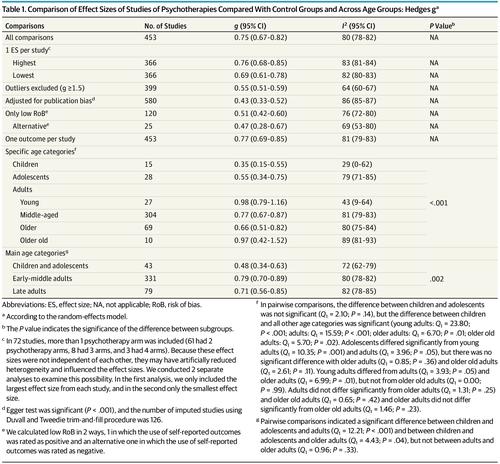JAMA Psychiatry ( IF 22.5 ) Pub Date : 2020-07-01 , DOI: 10.1001/jamapsychiatry.2020.0164 Pim Cuijpers 1 , Eirini Karyotaki 1 , Dikla Eckshtain 2 , Mei Yi Ng 3 , Katherine A Corteselli 4 , Hisashi Noma 5 , Soledad Quero 6 , John R Weisz 4

|
Importance It is not clear whether psychotherapies for depression have comparable effects across the life span. Finding out is important from a clinical and scientific perspective.
Objective To compare the effects of psychotherapies for depression between different age groups.
Data Sources Four major bibliographic databases (PubMed, PsychINFO, Embase, and Cochrane) were searched for trials comparing psychotherapy with control conditions up to January 2019.
Study Selection Randomized trials comparing psychotherapies for depression with control conditions in all age groups were included.
Data Extraction and Synthesis Effect sizes (Hedges g) were calculated for all comparisons and pooled with random-effects models. Differences in effects between age groups were examined with mixed-effects subgroup analyses and in meta-regression analyses.
Main Outcomes and Measures Depressive symptoms were the primary outcome.
Results After removing duplicates, 16 756 records were screened and 2608 full-text articles were screened. Of these, 366 trials (36 702 patients) with 453 comparisons between a therapy and a control condition were included in the qualitative analysis, including 13 (3.6%) in children (13 years and younger), 24 (6.6%) in adolescents (≥13 to 18 years), 19 (5.2%) in young adults (≥18 to 24 years), 242 (66.1%) in middle-aged adults (≥24 to 55 years), 58 (15.8%) in older adults (≥55 to 75 years), and 10 (2.7%) in older old adults (75 years and older). The overall effect size of all comparisons across all age groups was g = 0.75 (95% CI, 0.67-0.82), with very high heterogeneity (I2 = 80%; 95% CI: 78-82). Mean effect sizes for depressive symptoms in children (g = 0.35; 95% CI, 0.15-0.55) and adolescents (g = 0.55; 95% CI, 0.34-0.75) were significantly lower than those in middle-aged adults (g = 0.77; 95% CI, 0.67-0.87). The effect sizes in young adults (g = 0.98; 95% CI, 0.79-1.16) were significantly larger than those in middle-aged adults. No significant difference was found between older adults (g = 0.66; 95% CI, 0.51-0.82) and those in older old adults (g = 0.97; 95% CI, 0.42-1.52). The outcomes should be considered with caution because of the suboptimal quality of most of the studies and the high levels of heterogeneity. However, most primary findings proved robust across sensitivity analyses, addressing risk of bias, target populations included, type of therapy, diagnosis of mood disorder, and method of data analysis.
Conclusions and Relevance Trials included in this meta-analysis reported effect sizes of psychotherapies that were smaller in children than in adults, probably also smaller in adolescents, that the effects may be somewhat larger in young adults, and without meaningful differences between middle-aged adults, older adults, and older old adults.
中文翻译:

跨年龄段抑郁症的心理治疗:系统评价和荟萃分析。
重要性 目前尚不清楚抑郁症的心理治疗在整个生命周期中是否具有可比的效果。从临床和科学的角度来看,发现很重要。
目的 比较不同年龄段心理治疗对抑郁症的疗效。
数据来源 检索了四个主要书目数据库(PubMed,PsychINFO,Embase和Cochrane),以比较心理治疗与控制条件(截至2019年1月)的试验。
研究选择包括 比较所有年龄段抑郁症心理治疗与对照条件的随机试验。
计算所有比较的数据提取和综合效应大小(Hedges g),并与随机效应模型合并。年龄组之间的效果差异通过混合效果亚组分析和荟萃回归分析进行了检验。
主要结果和措施 抑郁症状是主要结果。
结果 去除重复项后,筛选了16 756条记录,筛选了2608篇全文文章。在这些定性分析中,纳入了366项试验(36 702例患者),其中将治疗与对照条件进行了453项比较,其中包括13例(3.6%)儿童(13岁以下),24例(6.6%)青少年( ≥13至18岁),年轻人(≥18至24岁)19(5.2%),中年成年人(≥24至55岁)242(66.1%),老年人58(15.8%)( ≥55至75岁),而老年人(75岁及以上)为10(2.7%)。所有年龄组的所有比较的总体效果大小为g = 0.75(95%CI,0.67-0.82),异质性很高(I 2 = 80%; 95%CI:78-82)。儿童抑郁症状的平均效应量(g = 0.35;95%CI(0.15-0.55)和青少年(g = 0.55; 95%CI,0.34-0.75)显着低于中年成年人(g = 0.77; 95%CI,0.67-0.87)。年轻人的影响量(g = 0.98; 95%CI,0.79-1.16)显着大于中年人。老年人(g = 0.66; 95%CI,0.51-0.82)与老年人(g = 0.97; 95%CI,0.42-1.52)。由于大多数研究的次优质量和高度的异质性,应谨慎考虑结局。但是,大多数主要研究结果在敏感性分析,偏倚风险,包括的目标人群,治疗类型,情绪障碍的诊断以及数据分析方法等方面均证明是可靠的。
该荟萃分析中的结论和相关性试验报告说,儿童心理治疗的效果大小比成人小,青少年也可能较小,年轻人的影响可能更大,而中年成年人之间没有有意义的差异,老年人和老年人。











































 京公网安备 11010802027423号
京公网安备 11010802027423号